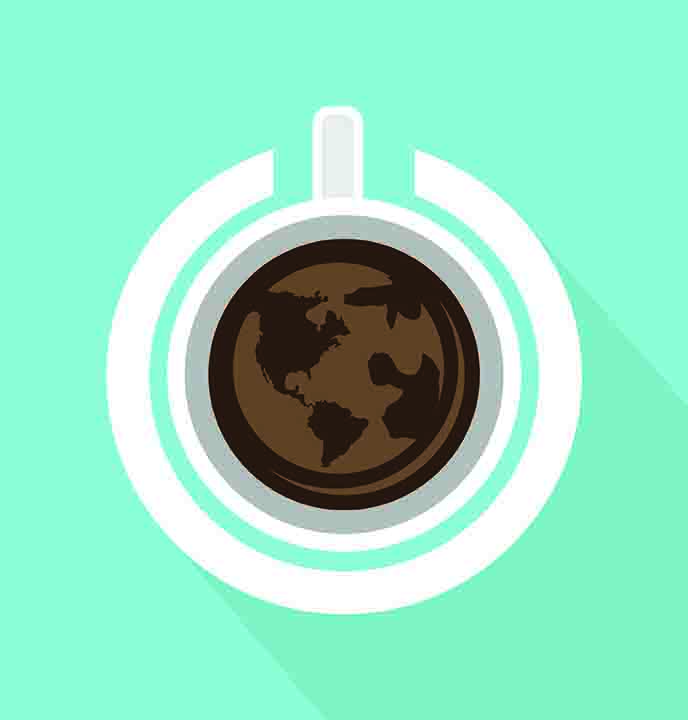The 8s
World of Coffee: A global glimpse at the world’s most popular beverage
November, 2019

The International Coffee Organization claims to have found 124 different species of coffee, but only two of them are actually used to make the beverage. One is the Arabica bean, a sweeter offering compared to the robusta, which is considerably stronger. But combine their genetic makeup with the growing environments of scores of nations that produce the beans going into the drink, and you’ve got variety by the cupful. Here’s a list of what’s produced by the world’s largest coffee producers.

Brazil: 2,592,000 metric tons (5.7 billion lbs.)
By far, the world’s biggest producer of coffee, the country is also noted for creating the Cup of Excellence which adjudicates the quality of beans grown elsewhere on the planet. Brazil’s Arabica coffee beans are known for their low acidity and mild aroma with elements of honey and wheat.
Tasting Notes: Includes a flavor like peanuts with dried fruits with banana and raspberry features, finishing with a deep body and malted sweetness of milk chocolate and hazelnut.

Vietnam: 1,650,000 metric tons (3.6 billion lbs.)
The world’s second largest producer and tops in terms of its robusta bean crop, Vietnamese coffee is sharp and bitter because of a caffeine content that’s almost twice that of what you’d find in an Arabica. It’s often served slow-dripped resulting in a rather thick beverage.
Tasting notes: If you can get past its potency, there’s a nutty flavour to the concoction. It’s usually served with cream and sugar for obvious reasons.

Colombia: 810,000 metric tons (1.8 billion lbs.)
While ranking third in terms of global production, coffee from this nation gets a thumbs-up literally everywhere on the planet. The Colombian Supremo designation is marketed as a being the highest symbol of quality.
Tasting Notes: A product renowned for its smooth body, mellow acidity, subtle floral and tropical fruit features combined with a strong caramel sweetness and a familiar roasted cola flavor.

Indonesia: 660,000 metric tons (1.5 billion lbs.)
The South Pacific region is plentiful in a number of Arabic variations, the most popular being the Java bean, once known to create the world’s best coffee. There’s no doubt why “Java” is a word used to refer to coffee, since the bean is known for its low acidity.
Tasting notes: a taste like brown sugar and elements of spice and earthy aromas such as cedar wood. While great on its own, Java is often used as a blend for other coffees.

Ethiopia: 384,000 metric tons (847 million lbs.)
This country is credited with first bringing coffee to civilization and to that end, the land offers the greatest diversity of flavour of any country in the world. So highly regarded is coffee in the nation that the drink is a traditional way to welcome guests and usually involves a coffee ceremony which can last for hours.
Tasting Notes: From bright, fruit flavours such as blueberry and blackberry with floral overtones to rich and earthy flavours of baking spices.

Honduras: 348,000 metric tons (767 million lbs.)
Coffees from this Latin American nation are praised for their full-bodied taste laces with textures that are sweet and mild. Much of that has to do with them being grown in the mountains as higher altitudes, which make them grow slow enough to absorb the minerals and soil nutrients responsible for their flavours.
Tasting notes: Ranging from hazelnut and vanilla to chocolate with a soft acidity.

India: 348,000 metric tons (767 million lbs.)
The country might be better known for its tea and chai, but its contribution to coffee culture is massive. It’s famous for offering “Monsooned Malabar” beans, which are exposed to monsoon rains and winds for three to four months. The beans are mostly shade-grown, among spice crops of clove, cardamom, cinnamon and nutmeg.
Tasting notes: The medium-body results are some bright fruity flavours like woody, nutty elements of exotic spice and an almost musty undertone.









